Diagnostic Immunology - PowerPoint PPT Presentation
1 / 24
Title:
Diagnostic Immunology
Description:
Immunology Tutorial Introduction & Course outline By: Moh d J. Al Khatatneh Immunological Reactions The ability to visualize Ab-Ag reactions is a powerful tool for ... – PowerPoint PPT presentation
Number of Views:594
Avg rating:3.0/5.0
Title: Diagnostic Immunology
1
Immunology Tutorial Introduction Course
outline By Mohd J. Al Khatatneh
2
Immunological Reactions
- The ability to visualize Ab-Ag reactions is a
powerful tool for detecting, identifying, and
quantifying antibodies or antigens. - One may detect or identify an unknown antibody
using a known antigen, or vice versa, one may use
an antibody of known specificity to detect or
identify an unknown antigen. - This is the underlying basis of immunological
testing.
3
Characteristics aimed for in immunological
testing
- Specificity is the ability of a test to measure
what is intended. A test with good specificity
gives few false positive reactions. For example,
an antibody which is specific will not
cross-react. - Sensitivity is the ability of a test to detect
very, very small amounts of what is intended. A
test with good sensitivity gives few false
negative reactions. For example, an antibody
that is very sensitive will detect minute
quantities of its corresponding antigen.
4
Serology
- Serology is a branch of immunology that deals
with the in vitro diagnostic testing of
antibodies and/or antigens (most often serum is
used).
5
- Serological tests
6
Serology
Antibody Type Antigen Called Reaction Called Definition
Precipitin Precipitinogen Precipitation The formation of an insoluble complex composed of a soluble Ag and a soluble Ab.
Agglutinin Agglutinogen Agglutination The cross-linking of a particulate or insoluble Ag by the corresponding Ab.
Hemolysin Hemolysis A reaction where the antibody is directed towards a red cell antigen and complement is activated to the C9 stage and the red cells are lyzed.
Cytolysin Cytolysis A reaction where the antibody is directed towards a cell other than a red cell and complement is activated to the C9 stage and the cell is destroyed.
Antitoxin Toxin In this reaction the antibody is directed towards a toxin, usually bacterial, and it neutralizes the toxin making it harmless.
7
Precipitation reactions
- Visible soluble precipitate
- mix soluble antigen and antibody
- excess antigen or antibody--no precipitate
- zone of equivalence--precipitate forms
8
Zone of equivalence
- change the amount of antigen
- constant amount of antibody
9
Gel precipitation
- Agar dish
- solid medium
- One well contains antibody
- Other well contains antigen
- Allow diffusion
- Form precipitate at zone of equivalence
10
Double immunodiffusion
- Two antigens and one antibody
- Place in separate wells
- Allow diffusion
- Lines of precipitation
- continuous
- identical antigens
- crossing lines
- completely different antigens
- continuous with spur
- partial identity
11
Single immunodiffusion
- Antibody mixed into gel
- specimens in well
- screening for presence of antigen
- precipitate forms band around well
- indicate presence of antigen
- size of band relative to concentration
- of antigen
12
Immunoelectrophoresis
- Separate antigens before testing
- put antigen in well
- expose to electrical field
- antigens are separated by size and charge
- add antibody and allow diffusion and
precipitation - precipitation with specific antibody gives
identity of antigen
13
(No Transcript)
14
Agglutination reactions
- Similar to precipitation reaction
- Visible reaction because antigen or antibody is
on larger molecule - cell
- latex bead
- Interaction of antigen and antibody
- clumping of large particles
15
Agglutination reactions
- Direct--detect antibodies
- using cells with antigen on them
- Indirect--detect antigen or antibody
- coated spheres or cells
- observe agglutination
- Hemagglutination
- Red blood cells agglutinate
- certain viruses (influenza)
16
Qualitative agglutination
- Known antigen in fluid
- Unknown specimen added
- Agglutination
- positive reaction
- No agglutination
- negative reaction
17
Quantitative agglutination
- Similar to qualitative
- Diluted samples of antibody
- Measure amount of agglutination for each dilution
18
Complement fixation
- Positive reaction
- Antibody present in serum
- Serum added to test antigen
- Bound antibody fixes complement
- No available complement to lyse indicator cells
19
Complement fixation
- Negative reaction
- No antibody in serum
- Complement not fixed
- Free complement lyses indicator cells
20
Immunoassays
- Detect antigen or antibody
- use a secondary antibody
- tagged with marker
- radioactive
- fluorescent
- enzyme
- Multiple samples tested at once
- Great sensitivity
- dependent on type of tag
- much greater than other tests
21
ELISA
- Example of immunoassay
- Indirect ELISA
- antigen coated to plastic well
- protein blocks remaining
- plastic surface
22
ELISA
- Serum added
- primary antibody
- if antibodies
- bind antigen
- if no antibodies
- antigen not bound
- Indicator antibody
- enzyme-linked anti-Ig antibody binds primary
antibody
23
ELISA
- Substrate
- specific for enzyme linked to secondary antibody
- enzyme causes substrate to change color
- Reactions
- color change
- antibody in serum
- no color change
- no antibody in serum
24
Immunofluorescence
- Antibody with fluorescent label
- Bind to cell
- Visualize under UV light
- Purpose
- detect specific proteins in cells
- detect viruses in cells
- identify microbial cells
- identify and sort cells
- fluorescent activated cell sorter































